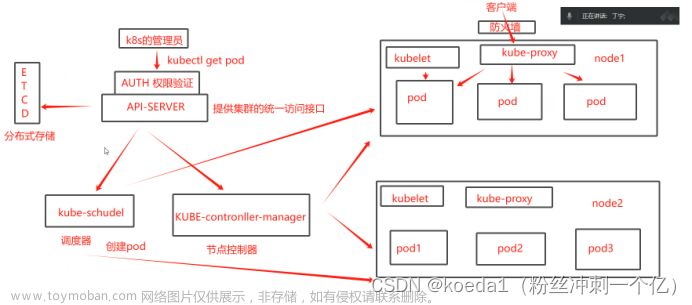目录
一、K8S的Service
1、Service的作用
2、Service类型:
二、ingress
1、ingress的组成:
2、ingress资源的定义项:
三、nginx-ingress-controller暴露服务端的方式
1、Deployment+LoadBalancer模式:
1、工作流程图:
2、Daemonset+hostnetwork+nodeSelector模式:
1、工作流程图
2、实验:
3、deployment+NodePort
1、实验:
4、通过虚拟主机的方式实现http代理
5、ingress实现https代理访问:
5.1、nginx的登录账户认证:
5.2、nginx的重写:
6、总结:
四、traefik-ingress暴露服务端的方式:
1、概念
2、工作流程图
3、traefik-ingress暴露服务端的方式
3.1、Daemonset模式:
3.2、deployment模式:
4、traefik-ingress和nginx-ingress的区别:
5、实验:
1、deployment模式:
2、Daemonset模式:
五、总结:
一、K8S的Service
1、Service的作用
Service的作用体现在两个方面:
1、集群内部:不断跟踪pod的变化,更新endpoints中的pod对象,基于pod的IP地址不断变化的一种服务发现机制
2、集群外部:类似负载均衡器,可以把流量IP+端口,不涉及转发url(http、https),把请求转发到pod中
2、Service类型:
NodePort:容器端口—Service端口—NodePort映射。设定了NodePort之后每个节点都会有一个端口被打开30000-32767
LoadBalancer:云平台上的Service服务。由云平台提供负载均衡的IP地址
ExternalName:域名映射
ingress:基于域名进行映射,转发的是url请求(http、https)转发到Service,再由Service转发到每一个pod
ingress只需要一个或者是少量的公网IP或者LB,可以把多个http请求暴露到外网
他是七层反向代理
可以将ingress理解为,Service的Service。是一组基于域名和url路径把请求转发到一个或者多个请求转发到Service的规则
ingress先七层转发转发都Service,Service再四层转发转发到pod
二、ingress
1、ingress的组成:
ingress是一个api对象,通过yaml文件来进行配置。ingress作用就是定义请求如何转发到Service的规则
ingress通过http和https暴露集群内部的Service,给Service提供一个外部的url、负载均衡、ssl/tls(https)的能力,实现一个基于域名的负载均衡
ingress-controller:由这个组件来具体的实现反向代理和负载均衡的程序,以及对ingress定义的规则进行解析,根据ingress的配置的规则进行请求的转发。
但是这个ingress-controller不是K8S自带的组件功能,ingress-controller是一个统称(一系列工具)
比如nginx ingress-controller、traefik都是ingress-controller,开源的软件
ingress-controller是pod的方式运行在节点上
2、ingress资源的定义项:
- 定义外部流量的路由规则
- 定义的服务暴露的方式、主机名、访问的路径和其他的一些选项
- 负载均衡(ingress-controller实现)
三、nginx-ingress-controller暴露服务端的方式
1、Deployment+LoadBalancer模式:
ingress部署在公有云。ingress配置文件中会有type。type:LoadBalancer。公有云平台会为这个LoadBalancer的Service自动创建一个负载均衡器。绑定公网地址
通过域名指向公网地址,实现集群对外暴露
1、工作流程图:
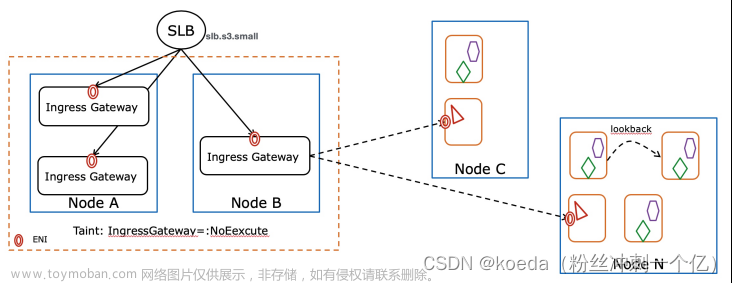
2、Daemonset+hostnetwork+nodeSelector模式:
Daemonset:在每个节点都会创建一个pod
hostnetwork:共享节点主机的网络命名空间。容器内直接使用节点主机的IP+端口。pod上的容器可以直接访问主机上的网络资源
nodeSelector:根据标签选择部署的节点。选择nginx-ingress-controller部署的节点
缺点:直接利用节点主机的网络和端口资源,一个node只能部署一个ingress-controller的pod
适用场景:大并发场景的生产环境。性能是最好的
1、工作流程图


Service和endpoints来发现节点
最终转发是由ingress-controller来转发请求(http)和负载均衡
用DaemonSet结合nodeselector来部署ingress-controller到特定的node上,然后使用HostNetwork直接把该pod与宿主机node的网络打通,直接使用宿主机的80/433端口就能访问服务。这时,ingress-controller所在的node机器就很类似传统架构的边缘节点,比如机房入口的nginx服务器。该方式整个请求链路最简单,性能相对NodePort模式更好。
缺点是由于直接利用宿主机节点的网络和端口,一个node只能部署一个ingress-controller pod。 比较适合大并发的生产环境使用。
2、实验:
#mandatory.yaml文件中包含了很多资源的创建,包括namespace、ConfigMap、role,ServiceAccount等等所有部署ingress-controller需要的资源。
官方下载地址:
wget https://raw.githubusercontent.com/kubernetes/ingress-nginx/nginx-0.25.0/deploy/static/mandatory.yaml
上面可能无法下载,可用国内的 gitee
wget https://gitee.com/mirrors/ingress-nginx/raw/nginx-0.25.0/deploy/static/mandatory.yaml
wget https://gitee.com/mirrors/ingress-nginx/raw/nginx-0.30.0/deploy/static/mandatory.yamlDaemonSet+HostNetwork具体的部署过程
下载安装ingress-controller pod及相关资源
每个节点上,上传ingress-contro控制器
解压安装
tar -xf ingree.contro-0.30.0.tar.gz
docker load -i ingree.contro-0.30.0.tar
#节点打标签,用于选择节点部署ingress-controller
kubectl label nodes node02 ingress=true192-215行修改配置文件

启动 nginx-ingress-controller,并检查该pod的运行状况
kubectl apply -f mandatory.yaml
#nginx-ingress-controller 已经运行 node02 节点
kubectl get pod -n ingress-nginx -o wide
kubectl get cm,daemonset -n ingress-nginx -o wide
#到 node02 节点查看
netstat -lntp | grep nginx
由于配置了 hostnetwork,nginx 已经在 node 主机本地监听 80/443/8181 端口。其中 8181 是 nginx-controller 默认配置的一个 default backend(Ingress 资源没有匹配的 rule 对象时,流量就会被导向这个 default backend)。
这样,只要访问 node 主机有公网 IP,就可以直接映射域名来对外网暴露服务了。如果要 nginx 高可用的话,可以在多个 node
上部署,并在前面再搭建一套 LVS+keepalived 做负载均衡。
创建 ingress 规则
创建一个业务pod和svc资源和ingress规则:
apiVersion: v1
kind: PersistentVolumeClaim
metadata:
name: nfs-pvc
spec:
accessModes:
- ReadWriteMany
storageClassName: nfs-client-storageclass
resources:
requests:
storage: 2Gi
---
apiVersion: apps/v1
kind: Deployment
metadata:
name: nginx-app
labels:
app: nginx1
spec:
replicas: 3
selector:
matchLabels:
app: nginx1
template:
metadata:
labels:
app: nginx1
spec:
containers:
- name: nginx
image: nginx:1.22
volumeMounts:
- name: nfs-pvc
mountPath: /usr/share/nginx/html
volumes:
- name: nfs-pvc
persistentVolumeClaim:
claimName: nfs-pvc
---
apiVersion: v1
kind: Service
metadata:
name: nginx-app-svc
spec:
ports:
- protocol: TCP
port: 80
targetPort: 80
selector:
app: nginx1
---
apiVersion: networking.k8s.io/v1
kind: Ingress
metadata:
name: nginx-app-ingress
spec:
rules:
- host: www.test1.com
http:
paths:
- path: /
pathType: Prefix
backend:
service:
name: nginx-app-svc
port:
number: 80#选择一台客户机,直接添加node02的节点的IP与pod的域名进行映射
vim /etc/hosts
20.0.0.63 www.test1.com
访问curl www.test1.com3、deployment+NodePort
同样用deployment模式部署ingress-controller,并创建对应的service,但是type为NodePort。这样,ingress就会暴露在集群节点ip的特定端口上。由于nodeport暴露的端口是随机端口,一般会在前面再搭建一套负载均衡器来转发请求。该方式一般用于宿主机是相对固定的环境ip地址不变的场景
NodePort方式暴露ingress虽然简单方便,但是NodePort多了一层NAT,在请求量级很大时可能对性能会有一定影响

1、实验:
如果做了上一个操作,就将所有的yaml文件通过delete进行清除。继续下面的操作
下载相关的ingress和service-nodeport模板
mkdir /opt/ingress/test
cd /opt/ingress/test
#官方下载地址:
wget https://raw.githubusercontent.com/kubernetes/ingress-nginx/nginx-0.30.0/deploy/static/mandatory.yaml
wget https://raw.githubusercontent.com/kubernetes/ingress-nginx/nginx-0.30.0/deploy/static/provider/baremetal/service-nodeport.yaml
#国内 gitee 资源地址:
wget https://gitee.com/mirrors/ingress-nginx/raw/nginx-0.30.0/deploy/static/mandatory.yaml
wget https://gitee.com/mirrors/ingress-nginx/raw/nginx-0.30.0/deploy/static/provider/baremetal/service-nodeport.yaml
#在所有 node 节点上传镜像包 ingress-controller-0.30.0.tar 到 /opt/ingress-nodeport 目录,并加载镜像
docker load -i ingress-controller-0.30.0.tar直接启动官方模板即可使用
#若是新的mandatory.yaml文件,直接启动即可,若是用上个实验的,要还原到最初始
kubectl apply -f mandatory.yaml还原脚本如下:
在所有节点上部署ingress-controller

#启用Service-nodeport
kubectl apply -f service-nodeport.yaml#//如果K8S Pod 调度失败,在 kubectl describe pod资源时显示:
Warning FailedScheduling 18s (x2 over 18s) default-scheduler 0/2 nodes are available: 2 node(s) didn't match node selector
解决方案:
1. 给需要调度的node加上对应标签
# 相对上面这个Yaml文件的例子
kubectl label nodes node_name kubernetes.io/os=linux
2. 删除Yaml文件中的nodeSelector,如果对节点没有要求的话,直接删除节点选择器即可
进行Ingress Http代理访问的操作演示
apiVersion: v1
kind: PersistentVolumeClaim
metadata:
name: nfs-pvc
spec:
accessModes:
- ReadWriteMany
storageClassName: nfs-client-storageclass
resources:
requests:
storage: 2Gi
---
apiVersion: apps/v1
kind: Deployment
metadata:
name: nginx-app
labels:
app: nginx1
spec:
replicas: 3
selector:
matchLabels:
app: nginx1
template:
metadata:
labels:
app: nginx1
spec:
containers:
- name: nginx
image: nginx:1.22
volumeMounts:
- name: nfs-pvc
mountPath: /usr/share/nginx/html
volumes:
- name: nfs-pvc
persistentVolumeClaim:
claimName: nfs-pvc
---
apiVersion: v1
kind: Service
metadata:
name: nginx-app-svc
spec:
ports:
- protocol: TCP
port: 80
targetPort: 80
selector:
app: nginx1
---
apiVersion: networking.k8s.io/v1
kind: Ingress
metadata:
name: nginx-app-ingress
spec:
rules:
- host: www.test1.com
http:
paths:
- path: /
pathType: Prefix
backend:
service:
name: nginx-app-svc
port:
number: 80访问IP+NodePort端口



工作流程:
每个节点都是从controller----接收到解析后的请求IP+端口----ingress-----Service----pod
总结:
nginx-ingress-controller
host—>ingresss的配置找到pod—>controller—>请求发到pod
nodeport--->controller--->ingress--->service--->pod
NodePort暴露端口的方式最简单的方法,NodePort多了一层nat(地址转换)
并发量大的对性能会有一定影响,内部都会用nodePort
4、通过虚拟主机的方式实现http代理
通过ingress的方式实现:一个ingress可以访问不同的主机
我们知道nginx和apache能够设置三种虚拟主机,分别为:基于IP,基于域名,基于端口。同样ingress-nginx这里也可以设置出这三种虚拟主机。下面将以最常用的基于域名的虚拟主机为例子,进行操作演示
先创建两个pod和Service
虚拟主机1:
apiVersion: apps/v1
kind: Deployment
metadata:
name: deployment1
labels:
test: nginx1
spec:
replicas: 1
selector:
matchLabels:
test: nginx1
template:
metadata:
labels:
test: nginx1
spec:
containers:
- name: nginx1
image: nginx:1.22
---
apiVersion: v1
kind: Service
metadata:
name: svc-1
spec:
ports:
- port: 80
targetPort: 80
protocol: TCP
selector:
test: nginx1虚拟主机2将上面标签全部替换

再创建ingress资源
apiVersion: networking.k8s.io/v1
kind: Ingress
metadata:
name: ingress1
spec:
rules:
- host: www1.test.com
http:
paths:
- path: /
pathType: Prefix
backend:
service:
name: svc-1
port:
number: 80
---
apiVersion: networking.k8s.io/v1
kind: Ingress
metadata:
name: ingress2
spec:
rules:
- host: www2.test.com
http:
paths:
- path: /
pathType: Prefix
backend:
service:
name: svc-2
port:
number: 80
映射域名:
vim /etc/hosts
#这里任意填写一个node节点的IP即可
20.0.0.62 www.test.com www.abc.com 然后就可以基于域名+NodePort端口进行访问了
5、ingress实现https代理访问:
需要证书和秘钥
创建证书 秘钥
secrets保存密钥信息,部署pod时把secrets挂载到pod
openssl req -x509 -sha256 -nodes -days 365 -newkey rsa:2048 -keyout tls.key -out tls.crt -subj "/CN=nginxsvc/O=nginxsvc"
req:生成证书文件的
x509:生成x.509自签名的证书
-sha256:表示使用sha-256散列算法
-nodes:表示生成到的秘钥不加密
-day 365:证书有效期365天
-newkey rsa:2048:RSA的密钥对,长度2048为位
-keyout tls.key -out tls.crt:密钥文件key,证书文件crt
-subj "/CN=nginxsvc/O=nginxsvc":主题,CN: common name O:kubectl create secret tls tls-secret --key tls.key --cert tls.crt
kubectl describe secrets tls-secret
创建deployment、service、ingress
vim traefik-nginx.yaml
apiVersion: apps/v1
kind: Deployment
metadata:
name: nginx-https
labels:
app: https
spec:
replicas: 3
selector:
matchLabels:
app: https
template:
metadata:
labels:
app: https
spec:
containers:
- name: nginx
image: nginx:1.22
---
apiVersion: v1
kind: Service
metadata:
name: nginx-svc
spec:
ports:
- port: 80
targetPort: 80
selector:
app: https
---
apiVersion: networking.k8s.io/v1
kind: Ingress
metadata:
name: nginx-ingress-https
spec:
tls:
- hosts:
- www.123ccc.com
secretName: tls-secret
rules:
- host: www.123ccc.com
http:
paths:
- pathType: Prefix
path: "/"
backend:
service:
name: nginx-svc
port:
number: 80访问测试
域名:https端口
curl -k https://www.123ccc.com:32561
是基于service-nodeport.yaml完成的,首先要有ingress-nginx

5.1、nginx的登录账户认证:
下载http,用htpasswd生成密钥(这里秘钥的名字只能值auth)

创建秘钥

生成新的ingress:
htpasswd -c auth koeda
New password: 123456
Re-type new password: 123456
kubectl create secret generic basic-auth --from-file=auth
vim ingress-auth.yaml
apiVersion: networking.k8s.io/v1
kind: Ingress
metadata:
name: ingress-auth
annotations:
#开启认证模块的配置
nginx.ingress.kubernetes.io/auth-type: basic
#设置认证类型为basic。是k8s自带的认证加密模块
nginx.ingress.kubernetes.io/auth-secret: basic-auth
#把认证的加密模块导入到ingress当中
nginx.ingress.kubernetes.io/auth-realm: 'Authentication Required-zyg'
#设置认证窗口的提示信息。
spec:
rules:
- host: www.zyg.com
http:
paths:
- path: /
pathType: Prefix
backend:
service:
name: nginx-svc
port:
number: 80
#使用http创建basic-auth
#开启认证加密的文件
#创建ingress开启认证模式
#将auth配置文件导入ingress当中
做映射www.koeda.com
在虚拟机访问测试
5.2、nginx的重写:
vim ingress-rewrite.yaml(要进入加入https端口)
apiVersion: networking.k8s.io/v1
kind: Ingress
metadata:
name: nginx-rewrite
annotations:
nginx.ingress.kubernetes.io/rewrite-target: https://www.123ccc.com:32561
spec:
rules:
- host: www.ddd.com
http:
paths:
- path: /
pathType: Prefix
backend:
service:
name: nginx-svc
port:
number: 80自定义域名需要映射

通过www.ddd.com+http端口访问

容器内页面跳转
到此nginx-ingress-controller全部介绍完毕
6、总结:
ingress两个重要的组件:
nginx-ingress-controller
traefik-ingress-controller
都是开源的ingress-controller
三种工作方式:
1、deployment+LoadBalancer,需要云平台提供一个负载均衡的公网地址,公有云上做
2、Daemonset+hostnetwork+nodeSelector,指定节点部署controller,缺点就是和宿主机共享网络,只能是一个controller的pod
hostnetwork这个配置回合宿主机共享网络资源
3、deployment+NodePort,最常见,最常用,也是最简单的方式。他是集中一个NodePort端口,所有的ingress的请求都会转发到NodePort,然后由Service把流量转发到pod
一个ingress的NodePort可以实现访问多个虚拟主机(域名),和nginx是一样的
四、traefik-ingress暴露服务端的方式:
1、概念
traefik是一个为了让部署微服务更加快捷而诞生的一个http反向代理,负载均衡
traefik设计时就能实时的和K8S的api交互,可以感知后端service以及pod的变化,还可以自动更新配置和重载
pod内nginx容器,80 8081
traefik的部署方式:
Daemonset和deployment
2、工作流程图

3、traefik-ingress暴露服务端的方式
3.1、Daemonset模式:
用的还是hostnetwork网络模式
特点:每个节点都会部署一个traefik。节点感知,可以自动发现,更新容器的配置,不需要手动重载
缺点:资源占用,大型集群中,Daemonset可能会运行多个traefik的实例,尤其是在节点上不需要大量容器运行的情况下。他是没有办法扩所容器的
适用于部署对外集群:因为对外的业务会经常变更,使用Daemonset模式可以更好的、自动的发现服务配置变更
3.2、deployment模式:
用的还是NodePort网络模式
优点:集中控制,可以使用少量的实例来运行处理整个集群的流量,更容易升级和维护。
缺点:
deployment负载均衡不会均匀地分布到每个节点。
需要手动更新,他无法感知容器的配置变化
适用于部署对内集群:对内的业务相对稳定,更新和变化也比较少,适合deployment的方式
一般部署的时候会设置标签:
traffic-type:internal 声明对内服务
traffic-type:external 声明对外服务
4、traefik-ingress和nginx-ingress的区别:
没有大区别
工作原理都一样,都是七层代理,都可以动态的更新配置,都可以自动发现服务
nginx-ingress:
自动更新的重载模块相对较慢
traefik-ingress
自动更新的重载模块更快、更方便
traefik的并发能力只有nginx-ingress的6成 60%
工作中见得最多的就是nginx-ingress-controller
5、实验:
1、deployment模式:
wget https://gitee.com/mirrors/traefik/raw/v1.7/examples/k8s/traefik-deployment.yaml
wget https://gitee.com/mirrors/traefik/raw/v1.7/examples/k8s/traefik-rbac.yaml
wget https://gitee.com/mirrors/traefik/raw/v1.7/examples/k8s/traefik-ds.yaml
wget https://gitee.com/mirrors/traefik/raw/v1.7/examples/k8s/ui.yaml
#先启动rbac权限配置
kubectl apply -f traefik-rbac.yaml
#再启动deployment或者Daemonset
kubectl apply -f traefik-deployment.yaml
#最后启动ui工具
kubectl apply -f ui.yaml

vim traefik-ingress-nginx.yaml
apiVersion: apps/v1
kind: Deployment
metadata:
name: nginx-traefik
labels:
nginx: traefik
spec:
replicas: 3
selector:
matchLabels:
nginx: traefik
template:
metadata:
labels:
nginx: traefik
spec:
containers:
- name: nginx
image: nginx:1.22
---
apiVersion: v1
kind: Service
metadata:
name: nginx-traefik-svc1
spec:
ports:
- port: 80
targetPort: 80
protocol: TCP
selector:
nginx: traefik
---
apiVersion: networking.k8s.io/v1
kind: Ingress
metadata:
name: nginx-traefik-test1
spec:
rules:
- host: www.yyw.com
http:
paths:
- path: /
pathType: Prefix
backend:
service:
name: nginx-traefik-svc1
port:
number: 80ui查看发现

2、Daemonset模式:
Daemonset,以及配置更新的自动重载
先运行traefik-ds.yaml,使用traefik的Daemonset+hostnetwork模式
创建configmap,挂载
worker_processes 2;
events {
worker_connections 1024;
}
http {
default_type application/octet-stream;
sendfile on;
keepalive_timeout 65;
server {
listen 80;
server_name localhost;
charset utf-8;
location / {
root /usr/share/nginx/html;
index index.html index.php;
}
error_page 500 502 503 504 /50x.html;
location = /50x.html {
root html;
}
}
}
kubectl create configmap nginx-con --from-file=/opt/nginx-configmap/nginx.conf创建业务资源,service和ingress
apiVersion: apps/v1
kind: DaemonSet
metadata:
name: nginx-app
labels:
app: nginx1
spec:
selector:
matchLabels:
app: nginx1
template:
metadata:
labels:
app: nginx1
spec:
containers:
- name: nginx
image: nginx:1.22
volumeMounts:
- name: nginx-config
mountPath: /etc/nginx/
- name: nginx-mount
mountPath: /usr/share/nginx/html
volumes:
- name: nginx-config
configMap:
name: nginx-con
- name: nginx-mount
hostPath:
path: /opt/html
type: DirectoryOrCreate
---
apiVersion: v1
kind: Service
metadata:
name: nginx-app-svc
spec:
ports:
- protocol: TCP
port: 80
targetPort: 80
selector:
app: nginx1
---
apiVersion: networking.k8s.io/v1
kind: Ingress
metadata:
name: nginx-app-ingress
spec:
rules:
- host: www.test1.com
http:
paths:
- path: /
pathType: Prefix
backend:
service:
name: nginx-app-svc
port:
number: 80hostnetwork端口80,nginx监听端口也是80
自动发现,ingress



apiVersion: apps/v1
kind: DaemonSet
metadata:
name: nginx-app
labels:
app: nginx1
spec:
selector:
matchLabels:
app: nginx1
template:
metadata:
labels:
app: nginx1
spec:
containers:
- name: nginx
image: nginx:1.22
volumeMounts:
- name: nginx-config
mountPath: /etc/nginx/
- name: nginx-mount
mountPath: /usr/share/nginx/html
volumes:
- name: nginx-config
configMap:
name: nginx-con
- name: nginx-mount
hostPath:
path: /opt/html
type: DirectoryOrCreate
---
apiVersion: v1
kind: Service
metadata:
name: nginx-app-svc
spec:
ports:
- protocol: TCP
port: 8081
targetPort: 8081
selector:
app: nginx1
---
apiVersion: networking.k8s.io/v1
kind: Ingress
metadata:
name: nginx-app-ingress
spec:
rules:
- host: www.test1.com
http:
paths:
- path: /
pathType: Prefix
backend:
service:
name: nginx-app-svc
port:
number: 8081重新运行,将hostnetwork的监听端口改成8081
kubectl edit cm nginx-con更改configmap,将nginx的监听端口改成8081



五、总结:
开源的ingress控制软件
nginx-ingress-controller
traefik-ingress-controller
nginx-ingress-controller:
模式:
deployment+LoadBalancer:公有云提供负载均衡的公网地址
Daemonset+hostnetwork+nodeSelector:和节点服务器共享网络,一个节点只能部署一个controller的pod,使用宿主机的端口,性能最好,适合大并发
deployment+NodePort:最常见也是最常用,也是最简单的方法。但是性能不太好,多了一层nat地址转发,不太适合大并发
traefik-ingress-controller:(小集群)
模式:
Daemonset模式:对外,可以自动更新容器的配置。hostnetwork模式,用的是节点网络
deployment模式:对内,无法自动更新配置。NodePort网络模式
https:
- 生成证书和秘钥
- 创建Secret保存秘钥
- 创建ingress的时候把Secret导入
加密认证:
1、借助htpasswd工具,生成名字叫 auth 的秘钥(文件名只能是auth)
2、创建ingress的两行代码文章来源:https://www.toymoban.com/news/detail-800428.html
 文章来源地址https://www.toymoban.com/news/detail-800428.html
文章来源地址https://www.toymoban.com/news/detail-800428.html
到了这里,关于【K8S 云原生】K8S的对外服务—ingress的文章就介绍完了。如果您还想了解更多内容,请在右上角搜索TOY模板网以前的文章或继续浏览下面的相关文章,希望大家以后多多支持TOY模板网!




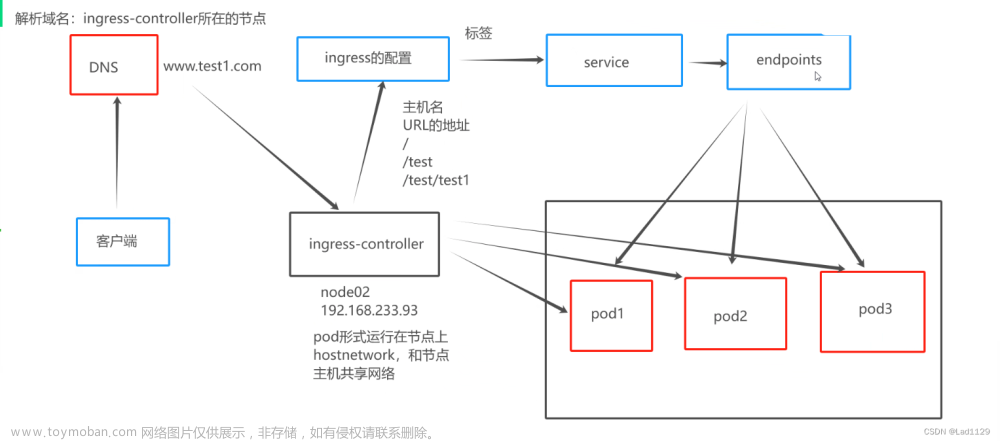
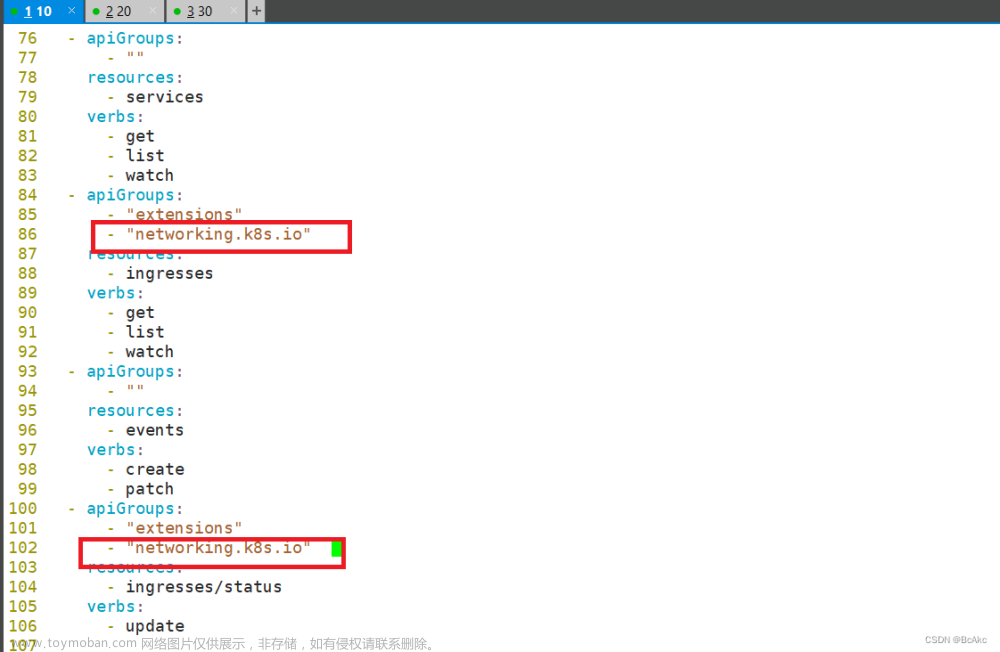
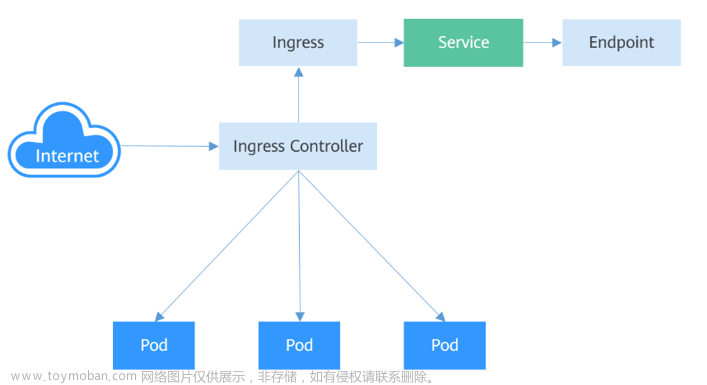
![[云原生] K8s之ingress](https://imgs.yssmx.com/Uploads/2024/04/848037-1.png)
